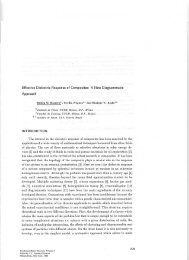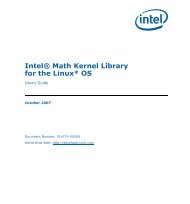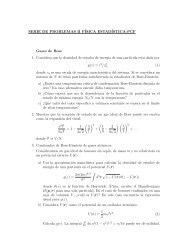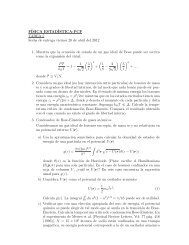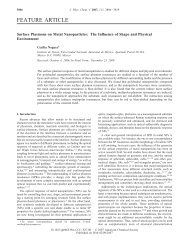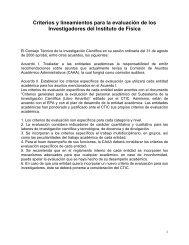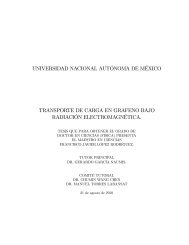The ID27 beamline at the European Synchrotron Radiation Facility ...
The ID27 beamline at the European Synchrotron Radiation Facility ...
The ID27 beamline at the European Synchrotron Radiation Facility ...
Create successful ePaper yourself
Turn your PDF publications into a flip-book with our unique Google optimized e-Paper software.
<strong>The</strong> <strong>ID27</strong> <strong>beamline</strong> <strong>at</strong> <strong>the</strong> <strong>European</strong> <strong>Synchrotron</strong> Radi<strong>at</strong>ion <strong>Facility</strong>:High Pressure Diffraction and High Pressure TomographyMSc. Michelle Jenice Alvarez Murga 1,21. <strong>ID27</strong>, Dynamics and Extreme Conditions Group, <strong>European</strong> <strong>Synchrotron</strong> Radi<strong>at</strong>ion <strong>Facility</strong>, Grenoble, France2. Institut Néel CNRS-UJF, Structure et Propriétés des M<strong>at</strong>ériaux – Conditions Extrêmes, Grenoble, FranceFirst Mexican <strong>Synchrotron</strong> Radi<strong>at</strong>ion User’s Meeting
Science <strong>at</strong> Extreme Conditions: multidisciplinary researchIn <strong>the</strong> last 5 years of oper<strong>at</strong>ion <strong>ID27</strong> has produced:•168 peer reviewed public<strong>at</strong>ions in different areas of research of which 15% appeared in “highprofile journals” with “Impact Factors” gre<strong>at</strong>er or equal than Physical Review Letters•1 public<strong>at</strong>ion/experiment in average (1/3 of <strong>the</strong>m from in-house research or strongcollabor<strong>at</strong>ions)First Mexican <strong>Synchrotron</strong> Radi<strong>at</strong>ion User’s Meeting
<strong>ID27</strong> staff: High Pressure Diffraction expertsM. MezouarBeamline responsibleG. GarbarinoBeamline scientistLow Temper<strong>at</strong>uresP.BouvierCollabor<strong>at</strong>or scientistRamanS.BauchauBeamline TechnicianA. Salam<strong>at</strong>Postdoctoral fellowChemistry and LaserHe<strong>at</strong>ing in DACS. PetitgirardPostdoctoral fellowResistive He<strong>at</strong>ing andLarge Volume PressM. Alvarez-MurgaPhD studentTomography and LargeVolume PressFirst Mexican <strong>Synchrotron</strong> Radi<strong>at</strong>ion User’s Meeting
<strong>ID27</strong> advanced sample environment•Diamond anvil cell :P>300 GPa, 5
<strong>ID27</strong> Low T sample environment•Commercial He flow cryost<strong>at</strong> by OxfordInstalled since September 2007T ≥ 4K•In-house made He flow cryost<strong>at</strong>Installed since September 2010T ≥ 3K, (20 min to 5K, 0.35l/h@15K)Both cryost<strong>at</strong>s are completely autom<strong>at</strong>edpermanent facilities @ <strong>ID27</strong> and offerpossible Raman measurements and o<strong>the</strong>rtechniques (transport & magnetic)Specially designed for single crystalhigh pressure experiments <strong>at</strong> low T(sphere of confusion
<strong>ID27</strong> detectorsA good detector for high pressure must fulfill <strong>the</strong> following criteria:- a large input surface (>150 mm diameter)- high sp<strong>at</strong>ial resolution- high dynamic range (14 bits or more)- good sensitivity, even <strong>at</strong> high X-ray energies (60-80 keV)- fast reading (a few seconds or less)MAR CCD: 165 mm diameter14 bits dynamic range; readout time 4sLow sensitivity <strong>at</strong> high X-ray energiesMar345 on-line image pl<strong>at</strong>e: 345 mm diameter14 bits dynamic range; readout time 60 sHigh sensitivity <strong>at</strong> high X-ray energiesFirst Mexican <strong>Synchrotron</strong> Radi<strong>at</strong>ion User’s Meeting
<strong>The</strong> <strong>ID27</strong> <strong>beamline</strong> experimental setups•Infrastructure:2 dedic<strong>at</strong>ed hutchesEH1: Paris-Edinburgh press, Low T and resistively he<strong>at</strong>ed diamond anvil cellsEH2: YAG and CO2 laser he<strong>at</strong>ing (extra-space for complementary equipments)2 dedic<strong>at</strong>ed labor<strong>at</strong>ories (DAC/Paris-Edinburgh cell)First Mexican <strong>Synchrotron</strong> Radi<strong>at</strong>ion User’s Meeting
Paris-Edinburgh SetupFirst Mexican <strong>Synchrotron</strong> Radi<strong>at</strong>ion User’s Meeting
Low T diamond anvil cell setupFirst Mexican <strong>Synchrotron</strong> Radi<strong>at</strong>ion User’s Meeting
Double-sided laser hetaing systemFirst Mexican <strong>Synchrotron</strong> Radi<strong>at</strong>ion User’s Meeting
Strong collabor<strong>at</strong>ion with <strong>the</strong> ESRF sample environment unit:J. Jacobs and P. VanderlindenSt<strong>at</strong>e-of-<strong>the</strong>-art offline equipments to perform <strong>the</strong> mostchallenging cell loadings on-siteHigh Pressure LabLaser Drilling MachinesGas Loading SystemFirst Mexican <strong>Synchrotron</strong> Radi<strong>at</strong>ion User’s Meeting
Summary of <strong>ID27</strong> capabilites40002500Temper<strong>at</strong>ure vs. Pressure diagram – HP/HT technologiesavailable <strong>at</strong> <strong>ID27</strong>Laser he<strong>at</strong>ing1200T (K)600300100PE-cellresistive he<strong>at</strong>ing (external)He cooling0.2 3P (MBar)+ Time resolutionFirst Mexican <strong>Synchrotron</strong> Radi<strong>at</strong>ion User’s Meeting
Some examples of daily science <strong>at</strong> <strong>ID27</strong>• Physics,Chemistry,Biology …• Powder and single crystal structural characteriz<strong>at</strong>ion• Phase transitions• Melting curves• New m<strong>at</strong>erial syn<strong>the</strong>sis• Effect of pressure on chemical bonds: neighborsdistances, coordin<strong>at</strong>ion number, angles...• Structural rel<strong>at</strong>ions between polymorphs in <strong>the</strong> solidand liquid st<strong>at</strong>es <strong>at</strong> high pressure are poorlyunderstood.P=138 GPaMetallic O 2• Geophysics• Determin<strong>at</strong>ion of planets cores structures• Effect of light elements• W<strong>at</strong>er in <strong>the</strong> Earth’s upper mantle• Magmas...First Mexican <strong>Synchrotron</strong> Radi<strong>at</strong>ion User’s Meeting
Future of <strong>the</strong> <strong>beamline</strong>•Keep a high level of user and in-house research support•Install a new faster, more efficient, high energy planar detector(pixel or fl<strong>at</strong> panel detector)•Develop new type of experiments−In situ micro and nano-XRF in <strong>the</strong> double laser he<strong>at</strong>ed DAC−In situ micro XRD tomography in <strong>the</strong> rot<strong>at</strong>ive PE press⇒Transform <strong>ID27</strong> into a long <strong>beamline</strong> (3 rd experimental hutch <strong>at</strong>~100 meters from <strong>the</strong> source)First Mexican <strong>Synchrotron</strong> Radi<strong>at</strong>ion User’s Meeting
In situ micro XRD tomography (XRD-CT) in <strong>the</strong> rot<strong>at</strong>ive Paris-Edinburgh pressSince <strong>the</strong> end of 2009, <strong>ID27</strong> team has engaged important efforts to developin situ diffraction tomography (XRD-CT) studies under high pressure.<strong>The</strong> work of Michelle Alvarez <strong>the</strong>sis project is to develop <strong>the</strong> <strong>ID27</strong>-EH1tomography setupPRINCIPLE: tomography uses penetr<strong>at</strong>ing X-rays to exploit a specific contrast(absorption, fluorescence, diffraction ) and reconstruct an image from high resolution2D angular projections.HOW TO COUPLE THIS WITH HIGH PRESSURE?To achieve this, a new rot<strong>at</strong>ing tomography ParisEdinburgh cell with an angular acess of 180°hasbeen constructed and will be tested in June 2011.First Mexican <strong>Synchrotron</strong> Radi<strong>at</strong>ion User’s Meeting
‘Ambient conditions’ experimental setupXRD-CT uses X-raymicrobeams to maplocal crystallineproperties like phase,texture (orient<strong>at</strong>ion),l<strong>at</strong>tice strain and defectdensity in threedimensions (3D)FluorescenceImagingωyBeamzX-ray focusing opticsStructural ImagingyxAbsorption ImagingP. Bleuet, et al. N<strong>at</strong>ure M<strong>at</strong>erials, 7:468-472, June 2008.First Mexican <strong>Synchrotron</strong> Radi<strong>at</strong>ion User’s Meeting
Wh<strong>at</strong> do we get as result?...example on C602D p<strong>at</strong>tern recovery (by projection)<strong>The</strong> demonstr<strong>at</strong>ion, carried out on a high pressure quenchedC60 sample, reveals a new ill-ordered carbon phase with shortinterlayer distance (3.11 Å) and evidences concentric sp<strong>at</strong>ialdistribution of diamond, sp3 amorphous diamond and sp2graphite-like carbon.3D Structural phase map(A)<strong>The</strong> scanned dimensions are 1320 m length and 184 mthickness. <strong>The</strong> voxel size is (2.3×2.3×1.6 µm3).(B) <strong>The</strong> sc<strong>at</strong>tered intensity is rendered as a function of <strong>the</strong> realsample coordin<strong>at</strong>es (x, y, z)M. Alvarez-Murga et al., Submitted (2011).Phase-Sp<strong>at</strong>ial selective sc<strong>at</strong>tering analysis. (A) experimental(black) and calcul<strong>at</strong>ed (red) selectively recovered sc<strong>at</strong>teringp<strong>at</strong>terns and 2D (x, y, zi) reconstructions of(1) full sample cross-section(2) glass capillary amorphous signal(3) amorphous sp3-like carbon phase(4) cubic diamond “D” Fd-3m a=3.565(1)Ǻ(5) new ill-ordered carbon phase “S” with short interlayer distance3.114(1)Ǻ(6) sp2-like carbon “G” with interlayer distance 3.420(1)Ǻ
L<strong>at</strong>tice d-spacing mapsM. Alvarez-Murga et al., Submitted (2011).Here, we report <strong>the</strong> development of sc<strong>at</strong>tering resolved tomography by including <strong>the</strong> Bragg angle (2θ) as fourth dimension of aX-ray diffraction computed tomography experiment (x,y,z). This extension enables <strong>the</strong> 3D mapping of strain (l<strong>at</strong>tice spacingcontrast) . In this case l<strong>at</strong>tice d-spacing maps allow discrimin<strong>at</strong>ion of different strained diamond crystallites in <strong>the</strong> core of <strong>the</strong>sample with a high accuracy.2D (x, y) l<strong>at</strong>tice d-spacing maps of diamond phase(a) 2D reconstructions obtained <strong>at</strong> three different 2positions on <strong>the</strong> (311) cubic diamond reflection: lowfwhm (yellow), center-fwhm (orange), high-fwhm (red).<strong>The</strong> squares indic<strong>at</strong>e <strong>the</strong> zones of <strong>the</strong> sample th<strong>at</strong>were used to extract 1D sc<strong>at</strong>tering p<strong>at</strong>terns.Inset: <strong>The</strong> sc<strong>at</strong>tered intensity is rendered as a functionof real sample coordin<strong>at</strong>es (x, y, z) for different (i =1n)Bragg angles.(b) 2D l<strong>at</strong>tice d-spacingmaps using (111), (220), (311),(400) and (331) diamond reflections.(c) Calcul<strong>at</strong>ed l<strong>at</strong>tice d-spacing, of selected areas(same as in a).(d) Histogram of l<strong>at</strong>tice d-spacingdistribution of <strong>the</strong>seanalyzed areas.First Mexican <strong>Synchrotron</strong> Radi<strong>at</strong>ion User’s Meeting
Rot<strong>at</strong>ive Paris-Edinburgh pressHP-HT sp<strong>at</strong>ially resolved structural studies will help to clarify long-standing issues ofinhomogeneous phase transform<strong>at</strong>ion, local grain growth and elastic anisotropy, until nowinvestig<strong>at</strong>ed by classical HP-HT XRD and ultrasound velocities.[1]« New gener<strong>at</strong>ion of large volume cells for research under extremeconditions» High Pressures network Project CNRS 2009 – MRCT 2010-11.[2] Proposal MI-1086 Insitu X-ray Micro-Diffraction Computed Tomography(XRD-CT) under extreme conditions using a new rot<strong>at</strong>ion tomography Paris-Edinburgh cellSpecial thanks to Yann Le Godec and Julien Phillipe from IMPMCFirst Mexican <strong>Synchrotron</strong> Radi<strong>at</strong>ion User’s Meeting
Future in situ XRD-CT experiments on <strong>ID27</strong>…This technological development willprovide new scientific opportunities fororiginal and unique studies of phasetransitions, density, crystalliz<strong>at</strong>ion anddeform<strong>at</strong>ion in extreme environments.in situ diffraction tomographyin situ absorption tomographyMeasure glassdensities underpressurein situ deform<strong>at</strong>ion and radiographyCEA Tours : energetic m<strong>at</strong>erials subjected topressure and shear stress.¨We wish to characterize our m<strong>at</strong>erials in poredistribution and crystal structure according to<strong>the</strong> different stresses applied…¨First Mexican <strong>Synchrotron</strong> Radi<strong>at</strong>ion User’s Meeting
Thank you for your <strong>at</strong>tentionContact inform<strong>at</strong>ion: michelle.alvarez@esrf.frMichelle AlvarezM.Sc. M<strong>at</strong>erials Science and EngineeringPhD Student, Dynamics and Extreme Conditions Group<strong>ID27</strong> - High Pressure Beamline<strong>European</strong> <strong>Synchrotron</strong> Radi<strong>at</strong>ion <strong>Facility</strong> - ESRF6 rue Jules Horowitz, B.P. 220, F-38043 Grenoble Cedex, FranceTel: +33 (0)4 76 88 23 17Institut Néel CNRS-UJFStructure et Propriétés des M<strong>at</strong>ériaux – Conditions Extrêmes25 Avenue des Martyrs, B.P. 166, F-38042 Grenoble Cedex, FranceTel: +33 (0)4 76 88 74 23First Mexican <strong>Synchrotron</strong> Radi<strong>at</strong>ion User’s Meeting
Michelle Alvarez CV2009-201220062004-2007M1 Internship2008Chemical EngineeringProcess Engineer inmicroelectronicsHP-HT syn<strong>the</strong>sisPhD <strong>the</strong>sis on <strong>ID27</strong>In situ micro-XRD-tomography ofheterogeneous high pressurehightemper<strong>at</strong>ure forms of C60<strong>The</strong>sis directors:Mohamed MezouarJean-Louis HodeauM2 Internship2009Multiferroics and Fe-Asbased superconductorsDiffraction-TomographyMethod
ERROR: stackunderflowOFFENDING COMMAND: ~STACK:




